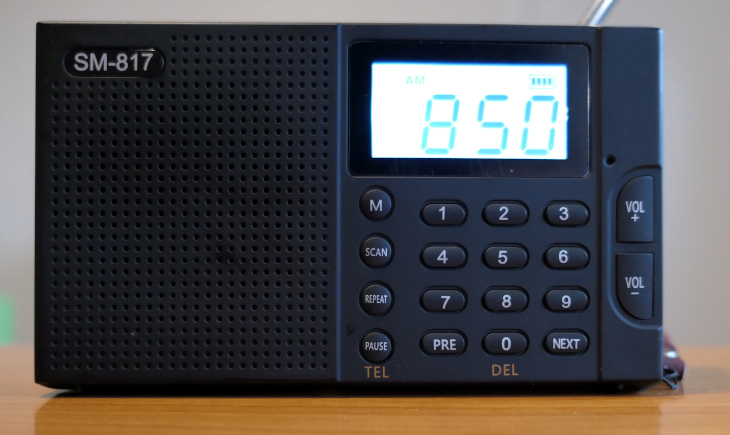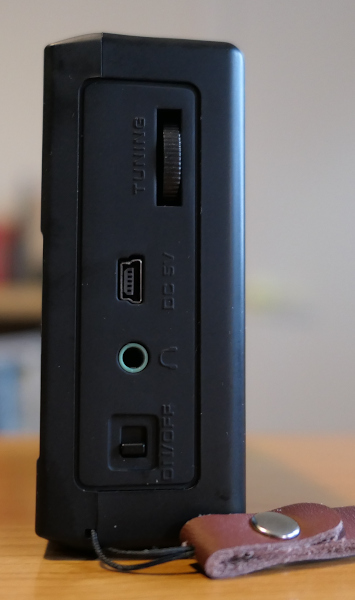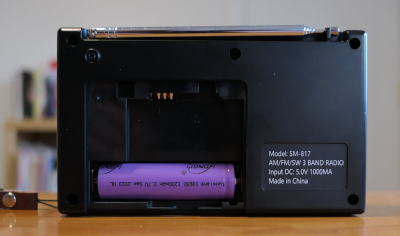
How much radio do you get for $20? You're about to find out!
When ordering a couple of other radios from Amazon in December 2024, I also got an offer for the "SEMIER" SM-817, which appeared to be a basic radio with a keypad. And it's certainly that.
Who's "SEMIER"? I don't know. The brand name appears nowhere on the radio, and it's not mentioned in the owner's manual, either. Amazon had a "SEMIER Store", where, in January 2025, it appeared that SEMIER specialized mostly in tape cassette players, some with radios included. Yet another mystery from the Chinese radio-industrial complex.
The radio package is pretty bare-bones: the radio, a USB cord, and an owner's manual. No frills here.

Yet there are a few unusual features, starting at the top of the radio (above). There's a slot for a microSD card, also known as a TF card, from which the SM-817 can play MP3 files. The owner's manual doesn't mention that this model can also play WAV files. It doesn't appear to support other formats.
The microSD card slot isn't so unusual. What is unusual is that white port next to the card slot: a USB type-A port! If you have MP3 files on a USB memory stick, you can plug it into the SM-817 and it will play those files just as it would from a microSD card.
Whenever you insert a microSD card or a USB drive into the SM-817, it will start playing files from the external card or drive. The M button can be used to get back to radio operation or to Bluetooth mode. Individual files can be addressed either by number, using the keypad, or with the PRE and NEXT buttons on the keypad.
Note that M stands for mode and not for "memory". This radio does not have memory storage.

The next unusual thing on the SM-817 is found on the right side of the radio (shown at left). There's a thumbwheel used for tuning the radio, which can be used instead of the keypad; an earphone jack; and a small on/off switch for the device. What's weird here is the USB port: it's a USB "mini" port that hasn't been in common use for electronic devices since the early 2010s! This one's a head-scratcher. A USB-C port would be the modern choice; a USB "micro" port would be more common, too. So to travel with this radio, you'd have to bring along adapters or cords for the older-style port.
The on-off switch is also an outdated design: it's purely mechanical, and rather tiny. The "up" position is "off" which seems counterintuitive to me. Every radio I've ever had was able to remember the frequency it was tuned to after each time it's been turned off and then turned back on again. Not this one. It does remember which band it was on. But it always defaults to 520 kHz on AM and 70.0 MHz on FM. There's also no way of setting the FM tuning range for different parts of the world.
There's also no clock, hence no alarm, either.

There's another surprise when opening the door to the battery compartment on the back side (right) of the SM-817. It can support either common type of rechargeable lithum-ion battery: a BL-5C or an 18650 battery. An 18650 is supplied with the radio; its current rating is 1200 mAh, indicating that this device doesn't consume a whole lot of power.
Why not just pick one type? Beats me.
I've already mentioned that the SM-817 does not have any memory function. It does have a scanning function, activated by the SCAN button, for automatically tuning stations.
How does it perform as a radio? First things first: there's no FM stereo. Music files do play back in stereo. But the SM-817 apparently doesn't decode stereo on FM radio.
On AM, the radio isn't adequately shielded from interference caused by the digital display. That noise drowns out many stations, and could even be heard on a local powerhouse such as KOA in Denver. The radio's designers may have realized this; the display shuts off after eight seconds, which also eliminates the noise.
On AM, I'd say this radio is an average performer, good enough for local stations and stronger stations in nearby areas. You won't DX with it for the most part. On FM, it's just not up to modern standards. Sensitivity is below average in my estimation. For selectivity, I have a particularly difficult test: separating 93.7, 93.9, and 94.1 MHz, all of which in Denver are home to either low-power FM stations or low-power translators. The SM-817 can't keep these three signals apart. On some other frequencies, I noted hints of spurious images. They weren't bad, and it was the kind of thing you'd get in radios from 30 years ago, but unexpected for a radio built in 2024.
I didn't do a head-to-head comparison with other radios because it was quite evident that the SM-817 was not going to be a top-tier performer or even close to that.
So this is what I got for $20. As I was writing this review, I saw that Amazon was offering the radio for $16. I'd honestly have to say that even $16 is too high a price for what you get. Even the unusual features of this radio really don't make it a keeper for me. I'll probably return it. (Update: I returned it.)